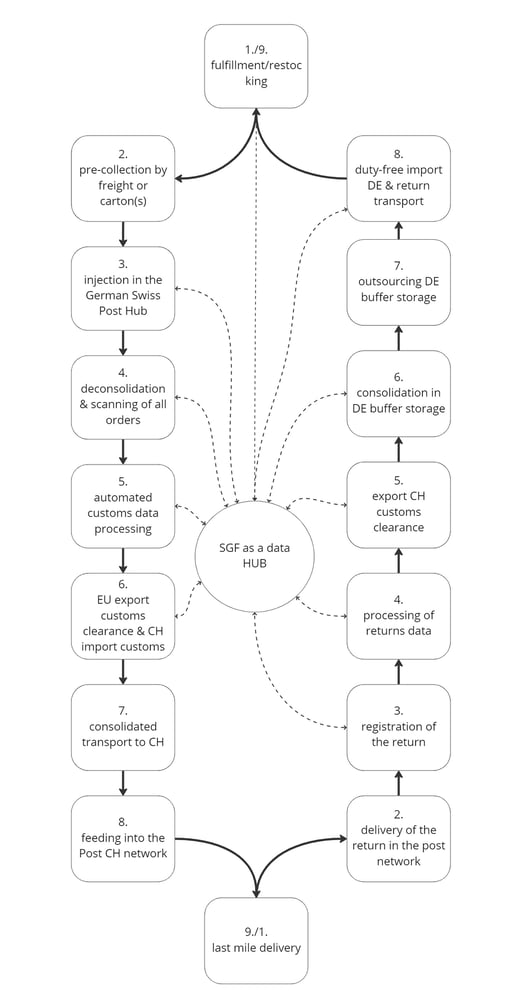This article gives you a process overview for the SmartGate Flex (SGF) logistics product. We also look at the returns management process and show where SGF acts as a data hub.
Caution: especially data-intensive process components (see dashed lines) are often, with less integrated logistics products, a pain point, which leads to high ongoing admin efforts and delivery delays.
 Export to Switzerland
Export to Switzerland
- the order is received in the retailer's online store and fulfilled. During labeling, the correct channel-dependent label must be applied depending on the format. If this is not possible, Swiss Post can relabel the shipments (depending on the effort, this is associated with extra costs). The relevant shipping & customs data are automatically transmitted via the interface.
- the orders are shipped to our Injection-Hub. This can be done with box in box principle or via freight (partial load/dedicated transport).
- the orders are injected into our DE-HUB.
- in our hub, the orders are deconsolidated and scanned based on the data already transferred.
- the captured shipments, in combination with the available data, form the basis for customs data preparation
- both the European export and the swiss import are processed with commercial customs clearance.
- there is a consolidated transport from our injection hub in Germany to our logistics center in Switzerland.
- your orders are fed into a Swiss Post logistics center
- on the next day the priority shipments are delivered or on the day after next the economy shipments (letter shipments are always delivered with priority).
Export from Switzerland (returns)
- Your Swiss customer prepares the return. He can use a label that was enclosed in the shipping box or order it on demand.
- The returns are picked up from the CH customer or dropped off at a Post CH dropoff point. Swiss Post transports the returns on the first mile to our Swiss Returns Hub.
- we record your returned items. If required, we carry out special processes.
- we prepare the returns data for various reporting purposes (refunding, customs clearance, etc.).
- we carry out the export customs clearance from Switzerland
- we transfer and consolidate your returns in our intermediate warehouse in Germany.
- we store your returns from our intermediate warehouse
- we import your goods duty-free to Germany and transport your returns back to your warehouse (via freight or outer carton)
For detailed questions, you are welcome to discuss our joint possibilities with a product consultant.
Data is king-without a data hub, relaxed cross-border eCommerce is impossible
The graphic should make clear that many components in the cross-border eCommerce value chain are data-based. When returns occur, we are talking about four customs clearance processes-without data they cannot take place! This is also true for stocking, retrieval, and handling processes. Of course, the required data can also be distributed manually between various stakeholders via Excel or CSV files. However, this is not a professional and sustainable approach in terms of process reliability and efficiency.
Ergo, our specially developed logistics software "NES" (New Eco System) acts as a data hub that orchestrates all data flows for retailers and shoppers.
If you want to know more details about our integration options you can get detailed information in this knowledge article.
